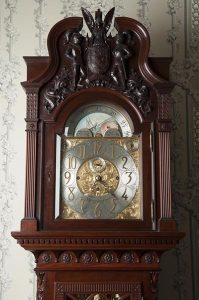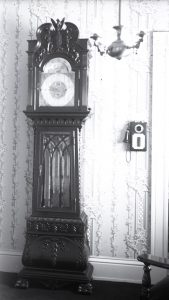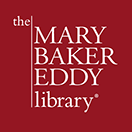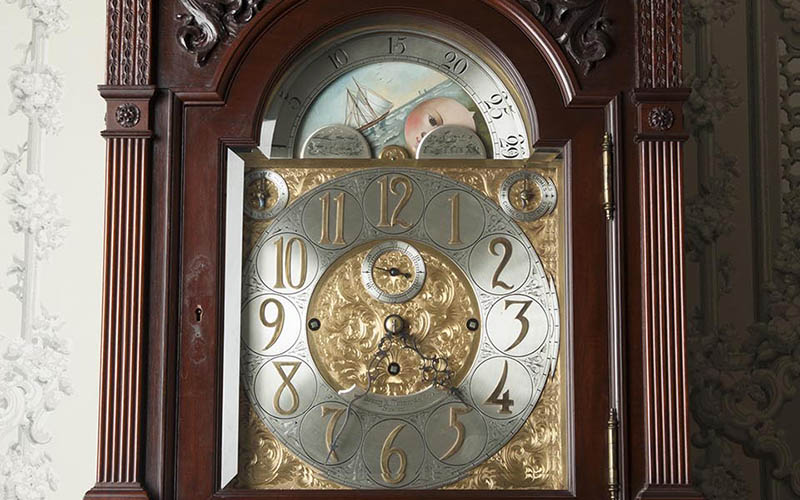Photograph of the top (bonnet) of the clock (0.0945), showing the carved Ambrose coat of arms. Photograph by Mark Thayer.
A particularly magnificent hand-carved grandfather clock stood near the entrance of Mary Baker Eddy’s home in Chestnut Hill, Massachusetts. One of her secretaries, Adam Dickey, mentions this clock in his Memoirs of Mary Baker Eddy: “On the left of the front hall is an aperture, or little hall, about ten feet square in which stands the stately hall clock, surmounted by the Ambrose coat of arms of our Leader’s mother’s family.”1
 Grandfather clocks—also known as longcase clocks, tall-case clocks, or floor clocks—were first developed in 1670 by British clockmaker William Clement. Before the advent of electronic clocks, longcase clocks were valued for their accurate timekeeping. The most common name used today is grandfather clock, said to have become widespread because of the popularity of a song titled “My Grandfather’s Clock.” It was written by American songwriter Henry Clay Work (1832-1884) and published in 1876. The song portrays the clock, purchased the day the grandfather was born, as particularly attuned to events in his life and includes the refrain “It stopped short—never to go again—when the old man died.”
Grandfather clocks—also known as longcase clocks, tall-case clocks, or floor clocks—were first developed in 1670 by British clockmaker William Clement. Before the advent of electronic clocks, longcase clocks were valued for their accurate timekeeping. The most common name used today is grandfather clock, said to have become widespread because of the popularity of a song titled “My Grandfather’s Clock.” It was written by American songwriter Henry Clay Work (1832-1884) and published in 1876. The song portrays the clock, purchased the day the grandfather was born, as particularly attuned to events in his life and includes the refrain “It stopped short—never to go again—when the old man died.”
How did Mary Baker Eddy come to own one of these imposing timepieces?
In 1892 Eddy reorganized the Boston church she’d formed in 1879 and gave it a new name—The Mother Church, The First Church of Christ, Scientist. Its original organization included the Christian Science Board of Directors, as well as a group of “First Members.” These charter members shared in the responsibility of conducting church affairs with the Board of Directors. (On January 10, 1901, the First Members relinquished their role in church government; on March 17, 1903, their designation became “Executive Members”; and on July 8, 1908, they were disbanded.)
The First Members gave Eddy this grandfather clock as a Christmas present in 1896. It stood in her Concord, New Hampshire, home until it was moved to Chestnut Hill, her last residence.

The grandfather clock at Eddy’s home in Chestnut Hill, Massachusetts, circa November 1908-December 1910, P05766, ©The Mary Baker Eddy Collection (click to see larger version)
The clock was the work of a company started by William H. Durfee of Providence, Rhode Island. Credited with popularizing grandfather clocks in the United States, he collaborated with the British firm Harrington’s, known for its production of beautifully toned tubular chimes. It seemed natural to begin installing these chimes in grandfather clocks, to strike the hour and quarter hours. Durfee’s company also supplied the Harrington tubular chimes that were installed in the tower of the Original Edifice of The Mother Church.
The demand for grandfather clocks containing tubular chimes grew to the point that Durfee authorized agents to sell them. One of these was Henry A. Turner & Co., and it was from Turner that the First Members purchased Eddy’s clock for $675 (a figure that equates to over $19,000 in today’s dollars).
On December 31, 1896, Eddy sent the First Members a letter thanking them for the clock. She wrote in part: “For your last Christmas gift I feel quite bankrupt in thanks. You have made me a timely present, one that gives a new tongue to time, that calls my attention to the loss of moments and to the gain of what is timeless, even eternity.”2 The First Members responded with a telegram dated January 2, 1897, which—like Eddy’s letter—points beyond the mortal sense of time to eternity:
…we the first members of your church felt our hearts thrill within us as never before, while listening to your letter of thanks to us for our Christmas present to you but small indeed was that as an expression of gratitude to you for all that you have done and are doing for us and for the world – We wish you this beautiful morning a Happy New Year not one but an eternity of them ….3


